中国文化概况Chapter1 ppt
中国文化概况
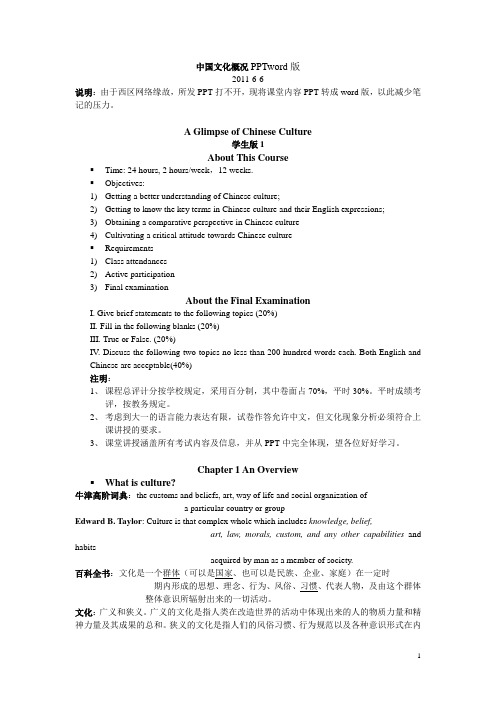
中国文化概况PPTword版2011-6-6说明:由于西区网络缘故,所发PPT打不开,现将课堂内容PPT转成word版,以此减少笔记的压力。
A Glimpse of Chinese Culture学生版1About This Course▪Time: 24 hours, 2 hours/week,12 weeks.▪Objectives:1)Getting a better understanding of Chinese culture;2)Getting to know the key terms in Chinese culture and their English expressions;3)Obtaining a comparative perspective in Chinese culture4)Cultivating a critical attitude towards Chinese culture▪Requirements1)Class attendances2)Active participation3)Final examinationAbout the Final ExaminationI. Give brief statements to the following topics (20%)II. Fill in the following blanks (20%)III. True or False. (20%)IV. Discuss the following two topics no less than 200 hundred words each. Both English and Chinese are acceptable(40%)注明:1、课程总评计分按学校规定,采用百分制,其中卷面占70%,平时30%。
平时成绩考评,按教务规定。
2、考虑到大一的语言能力表达有限,试卷作答允许中文,但文化现象分析必须符合上课讲授的要求。
中国传统文化介绍PPT课件

?
是 谁 呢
的 花 盆 。 那 么 第 一 个 发 明 制 陶 的 人
品 就 是 养 一 盆 花 也 需 要 有 一 个 陶 制
人 们 在 日 常 生 活 中 离 不 开 陶 瓷 制
陶 瓷 的 故 事
()
正 ” 官 员
。
后 来 黄 帝 任 命 宁 封 子 为 桥 国 的 “ 陶
了 很 久 发 现 装 进 泥 壳 里 的 水 点 滴 不 漏
以津张,是 捏,”它北 泥家创创方 人境始始流 为贫人于传 业寒叫清的 ,,张代一 养从明末派 家小山年民
,。
泥 人 张
趣反瞬色中
味面间,的
性 。
人 物 。 他 的 作 品 具 有 浓 厚 的
的 形 象 , 有 正 面 人 物 , 还 有
有 表 现 劳 动 人 民 现 实 生 活 中
人 物 , 也 有 小 说 戏 曲 中 的 角
确祭阳与“花阳重阳
每祖节推久节节九节
年的与行久等又”,
农四除敬”说称,农
历大、老,法“民历
九节清活有。登间九
月日、动长由高在月
初。盂。久于节该初
2012 12 28
九
三
之九”日九
为
节
意月。有,
老年也
,初还登二
年
是
所九有高九
节 。
月
中 国
以“重的相 常九九风重
日 , 法 律
传 统 节 日
在九节俗, 此”、,称 日谐茱所为 祭音萸以
春 节
同们因春
时便为节
期有相是
、贴传中
不春年国
同联兽及
地、怕一
区放红些
、鞭色亚
不炮,洲
同、怕民
中文《中国文化概览》PPT文稿
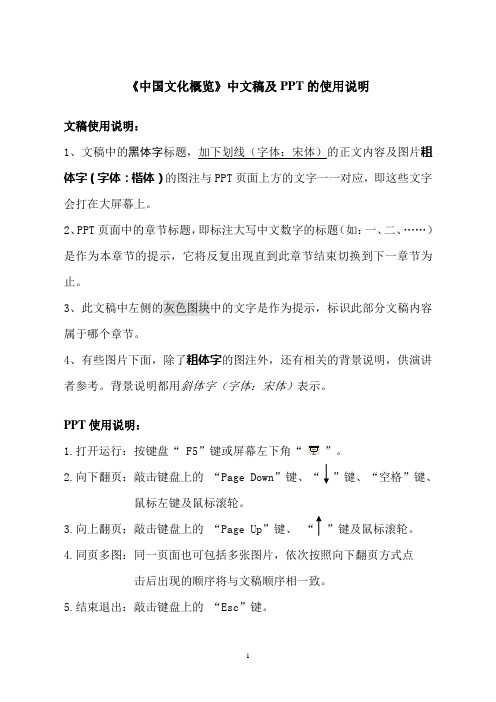
《中国文化概览》中文稿及PPT的使用说明文稿使用说明:1、文稿中的黑体字标题,加下划线(字体:宋体)的正文内容及图片粗体字(字体:楷体)的图注与PPT页面上方的文字一一对应,即这些文字会打在大屏幕上。
2、PPT页面中的章节标题,即标注大写中文数字的标题(如:一、二、……)是作为本章节的提示,它将反复出现直到此章节结束切换到下一章节为止。
3、此文稿中左侧的灰色图块中的文字是作为提示,标识此部分文稿内容属于哪个章节。
4、有些图片下面,除了粗体字的图注外,还有相关的背景说明,供演讲者参考。
背景说明都用斜体字(字体:宋体)表示。
PPT使用说明:1.打开运行:按键盘“F5”键或屏幕左下角“”。
2.向下翻页:敲击键盘上的“Page Down”键、“”键、“空格”键、鼠标左键及鼠标滚轮。
3.向上翻页:敲击键盘上的“Page Up”键、“”键及鼠标滚轮。
4.同页多图:同一页面也可包括多张图片,依次按照向下翻页方式点击后出现的顺序将与文稿顺序相一致。
5.结束退出:敲击键盘上的“Esc”键。
中国文化概览目录引言一、文明起源1、早期文明2、玉器文明3、青铜文明二、文字和语言1、汉字2、方言三、思想和文化1、儒家2、道家3、中国佛教4、史学四、文学1、诗歌2、散文3、小说五、艺术1、书法2、绘画3、雕塑4、建筑5、音乐6、舞蹈7、戏剧8、工艺美术●陶瓷●织锦●漆器9、民间艺术●杂技●其他手工艺六、文化交流1、中国古代文化交流2、中国现代文化交流结束语引言引言在亚洲东部,有一片960万平方公里的广袤土地,背靠“世界屋脊”青藏高原,自西向东,面对着浩瀚的太平洋,这就是中国56个民族的共同家园。
中国文化就是在这片土地上崛起和发展的。
中国文化崇尚整体思维,传统的中国哲学认为,宇宙中的各类事物之间存在着普遍的联系,天、地、人视为一个整体。
这样的哲学思想影响到了语言、文学、艺术等文化所涉及的各个领域,甚至老百姓的日常生活习俗。
在天、地、人的整体中,中国文化坚持以“人”为中心,重视个人的伦理修养,进而追求人格的完美;并崇尚“平和”,注重事物之间的平衡与和谐。
China 文化 PPT
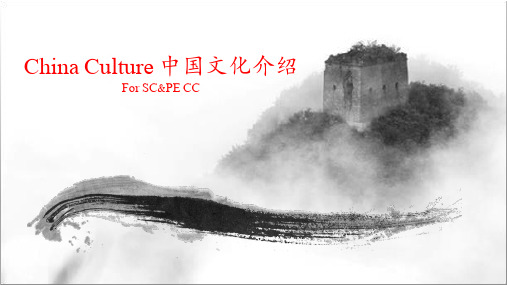
771—256 BC East Zhou Dynasty 东周
221—207 BC Qin Dynasty 秦朝
202 -220 BC Han Dynasty 汉朝
220--280 Three Country 三国
226--420 Jin Dynasty 晋朝
420--589 N&S Dynasty 南北朝
1912--Now 1949--Now Republic of People's China Republic of 民国 China 中国
China Geography 中国版图
1 Population 人口:
1.4 billion Chinese people 14亿
2 GDP 3 Area
国民总产值: 10 trillion US dollars in 2015
Clothing 衣
In the Past,before PRC establish(1949), Traditional styles, and no more choices. People wore clothes depending on their social statue. 物质匮乏,可选择性差,审美标准单一。 Nowadays, People choose what they like, depend on personality. China follows international fashion closely.
Beijing
Shanghai
Kunshan
Countryside
Transportation 出行
264 million motor vehicles totally Restriction policy is published in some cities:Beijing,Shanghai,Tianjin,Hanghzou,Shenzhen 2.64亿机动车保有量,包括农用车等 限行政策在大城市发布,包括北京,上海,天津, 杭州,深圳
中国文化概况课件Unit 1-3chapter 2 Philosophy and religions
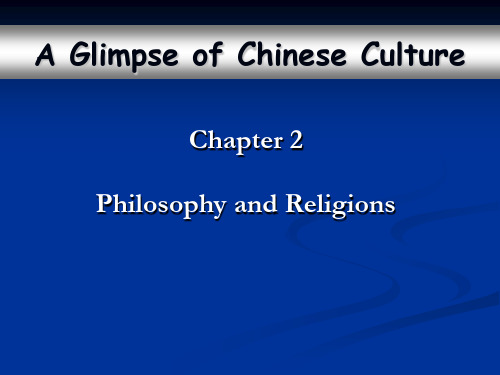
Confucianism
The school takes the teachings of Confucius as its core of thought and regards the words and deeds of Confucius as its highest code (准则) of behavior. It advocates the benevolence and justice, allegiance and forbearance (仁、义、忠、恕), the doctrine of the golden mean (中庸) and values the ethical relations of men.
The philosophy in Pre-Qin times (先秦子学)
The philosophy in Pre-Qin times was marked by the emergence of various ancient philosophical views. The most influential schools were Confucianism (儒家), Taoism (道家), Mohism (墨家) and Legalism (法家)
Legalism
Legalism, begun by Hanfeizi, espouses (主张) laying down laws to unify the thought of people, promoting agriculture to achieve affluence (富裕), waging (进行) wars to gain strength and power, and establishing a system of bureaucracy (官僚制度).
2024版《中国文化概论》PPT课件
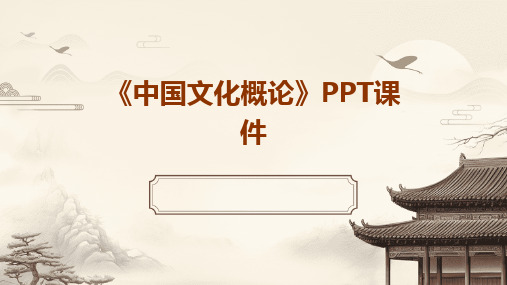
《中国文化概论》PPT课件目录CATALOGUE•中国文化概述•中国语言文字•中国哲学思想•中国文学艺术•中国传统节日与习俗•中国古代科技与发明•中国饮食文化01CATALOGUE中国文化概述文化的定义与特点文化的定义文化是一个国家或民族的历史、地理、风土人情、传统习俗、生活方式、文学艺术、行为规范、思维方式、价值观念等的总和。
文化的特点文化具有多样性、传承性、变异性、共享性和象征性等特点。
中国文化的起源与发展中国文化的起源中国文化起源于黄河流域的华夏文明,经过数千年的发展和演变,逐渐形成了独具特色的文化体系。
中国文化的发展中国文化在发展过程中,不断吸收和融合外来文化,同时也保持着自身文化的传承和发展,形成了丰富多彩的文化内涵。
天人合一天人合一是中国文化中的一种重要哲学思想,它认为人类和自然是一体的,人类应该顺应自然、与自然和谐相处,达到天人合一的境界。
仁爱思想中国文化强调仁爱思想,即关爱他人、尊重生命、热爱和平,这是中国文化中最重要的价值观之一。
中庸之道中庸之道是中国文化中的一种重要思想,它主张在处理事物时要保持适度、避免极端,追求平衡和和谐。
礼制精神中国文化注重礼制精神,即尊重传统、注重礼仪、讲究规矩,体现了一种对秩序和规范的尊重和维护。
中国文化的核心价值观02CATALOGUE中国语言文字结绳记事、仓颉造字等传说汉字的起源汉字的演变汉字的结构与特点甲骨文、金文、小篆、隶书、草书、楷书、行书等发展阶段象形、指事、会意、形声等造字法,以及汉字的表意性质030201汉字的起源与演变汉语的特点声调语言,音节清晰,词汇丰富,语法灵活汉语的传播与影响对周边国家语言文字的影响,以及汉语国际推广的现状与趋势汉语的魅力表达细腻,音韵和谐,文化底蕴深厚汉语的特点与魅力方言与少数民族语言中国方言的概况七大方言区及其特点少数民族语言文字多样性、丰富性及其保护传承的重要性方言与少数民族语言的文化价值对中华文化多元一体的贡献03CATALOGUE中国哲学思想儒家思想概述01儒家思想是中国传统文化的主流思想,强调仁、义、礼、智、信等道德观念,注重个人修养和社会和谐。
中国文化传统文化第1讲
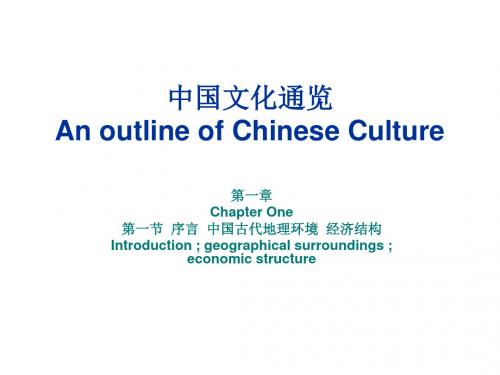
The relatively enclosed geographical surroundings provided exceptional natural advantages for the ancient Chinese culture to develop independently, for a fairly long period free from the impact of foreign cultures, especially those powerful ones. These facilitated the Chinese culture to evolve into a stable and independent system with distinctive regional features.
It belongs to the historical category, having undergone 5 000-year development before it turns into today’s splendid sight, both extensive and profound. To some extent the Chinese culture indicates the Chinese tradition. Meanwhile it can be relegated to the national category. After a long process of relatively independent development followed by the collision and exchange afterwards between China and foreign countries, the Chinese culture assumed unique characteristics, became an outstanding member in the brilliant global family of national cultures, and grew to be a main representative of Oriental national cultures.
2024版中国文化概论全套精品课件

06
中国现代文化变迁与展望
Chapter
西方文化对中国的影响
思想观念的冲击
西方自由、民主、平等等思想传入中国,对中国传统文化观念产 生深远影响。
生活方式的变化
西方现代生活方式,如服装、饮食、娱乐等逐渐融入中国人的日 常生活。
文化产业的兴起
西方文化产业模式为中国文化产业发展提供了借鉴和启示。
中国文化的现代化进程
春节 中国最重要的传统节日,历史悠久,由上古时代岁首祈岁 祭祀演变而来,人们通常会在这个时候进行大扫除、贴春 联、吃团圆饭、放烟火等庆祝活动。
元宵节 又称上元节或灯节,是春节之后的第一个重要节日,人们 会吃元宵、赏花灯、猜灯谜等。
其他节日 如立春、雨水、惊蛰等二十四节气,在古代农耕社会中具 有重要的指导作用,现在仍有一些地方会举行相关的庆祝 活动。
医学
古代中国医学以中医为代表,形成了独特的理论体系和诊疗方法,如望闻问切、针 灸推拿等,至今仍具有广泛应用价值。
药学
古代中国药学以《本草纲目》为代表,对药物进行了系统分类和记述,为后世药物 研究和应用提供了重要参考。
古代建筑与水利工程
建筑
古代中国建筑以木结构为主,注重空 间布局和美学效果,形成了独特的建 筑风格,如宫殿、寺庙、园林等。
文化多元化与冲突
随着文化多元化的发展,不同文化之间的冲突与融合 成为热点话题。
文化传承与创新
如何在传承传统文化的基础上进行创新,成为当代中 国文化发展的重要议题。
中国文化在全球化的挑战与机遇
1 2
全球化带来的文化冲击 全球化进程加速了不同文化之间的交流与融合, 同时也给中国文化带来了冲击和挑战。
全球化带来的发展机遇 全球化为中国文化走向世界提供了更广阔的舞台 和更多的机遇。
中国传统文化概述 课件

传文 统化
5 一、文化的概念
(1) (2)
物质文化层
物质文化是指人类通过加工自然创造的各种器物,是人的物质生 产活动及其产品的总和,属于实体文化。物质文化以满足人类的衣食 住行等基本生存需要为目标,反映了人类认识、利用和改造自然的程 度,同时也反映了社会生产力的发展水平。
制度文化层
制度文化是指人类在社会实践中建立的各种社会规范和社会组织,是 人们为了处理和解决各种社会矛盾、调整人与人之间的社会关系而制定的 各种法律、规范、准则、条例等, 是以社会制度形式呈现的文化现象。
传文 统化
6 一、文化的概念
(3)行为文化层
行为文化是指由人们在人际交往中约定俗成的习惯性定势构成的文化,是以民风民俗形式 出现的,存在于日常起居中的具有鲜明民族特色的行为模式。如《汉书·王吉传》中所说:“是 以百里不同风,千里不同俗”,就明确指出了人类行为文化的存在,并说明其具有民族性和 地域性的特点。
(一) (二) (三)
农耕经济与“重农抑商”政策 春秋时期,农为“本”,商为“末”的观念迅速形成 战国时期的李悝提出“尽地力之教” 秦通过法律形式确定了发展农业生产的政策
16 三、中华传统文化形成的政治环境
(一)宗法制度 宗法制度是中国古代维护贵族世袭的一种制度,这种制度确立于夏朝,发展于商朝,完备
传文 统化
▲现代藏族服饰
▲现代苗族服饰
7 一、文化的概念
(4)心态文化(精神文化)层
心态文化是指由人类社会实践和意识活动发展演化而来的价值观念、审美情趣、思 维方式等。心态文化层属于文化的核心,可以划分为社会心理和社会意识形态两个层 次。社会心理是指人们的要求、愿望、情绪等日常的精神状态和思想面貌,是尚未经 过理论加工和艺术升华的大众心态。而社会意识形态则是指经过系统加工的社会意识, 这些社会意识大多是由文化专家对社会心理进行理论归纳、逻辑整理、艺术完善,并 以著作、艺术作品等形式固定下来,流传后世的。
第一章 中国传统文化概况PPT

中国传统文化的基本精神
以贵刚经 人和健世 为尚有致 本中为用 的的的的 人和进务 文谐取实 精精精精 神神神神
1.以人为本的人文精神
重视人的生命、肯定人的价值。 《周易》:把人与天地并立,并强调“天地之间,莫贵于人” 《礼记》:“人者,天地之心也,五行之端也。” 孔子:“务民之义,敬鬼神而远之,可谓知矣。”
辉煌的文化成就 《史记》—史学 《古诗十九首》—诗歌 元典创制
道教、佛教——东汉
(四)魏晋南北朝—— 中国传统文化的融合期
融合期
多元的文化走向
多方创新的文化成就 数学—祖冲之 农学、地理学—《齐民要术》《水经注》 医学、化学—葛洪
(五)唐宋时期—— 中国传统文化的鼎盛期
鼎盛期
唐代 科学技术 文学 艺术
宋代 文学 书法 绘画 科技 教育
(六)明清——中国传统文化 的沉暮与创新
沉暮与创新
文化专制严厉 文字狱
早期启蒙思潮出现 李贽 王守仁 黄宗羲、顾炎武、王夫之
古典文化的总结时期 图书典籍 古代科技 学术文化
西学的传入与东渐
中国传统文化的 基本精神
结合所学知识和生活体 验,谈谈中国传统化的 基本精神有哪些?
范仲淹“先天下之忧而忧,后天下之乐而乐” 张载的“为天地立心,为生民立命,为往圣继绝学,为万世开太平”
匡衡凿壁借光
车胤囊萤
孙敬悬梁
苏秦刺股
孙康映雪 勾践卧薪尝胆
4.经世致用的务实精神
躬行践履,在实际工作和生活中追求人生理想,实现人生价值。
荀子:“道虽迩,不行不至;事虽小,不为不成”,
孔子:“敏于行”“敏于事”,“躬行君子,则吾未之有得”。 “力行近乎仁”
希腊哲学家 普罗泰戈拉
《论真理》:“人是万物的尺度”的哲学命题 西方“以人为本”思想的历史渊源。
中国传统文化介绍课件PPT
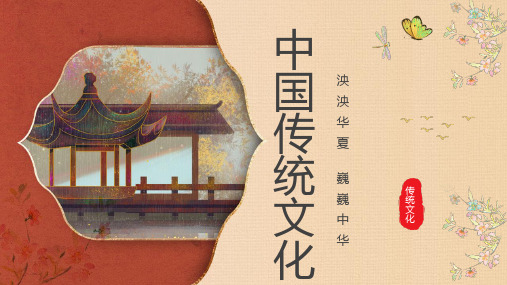
定义
01
中国传统文化是指在长期历史发展过程中形成和发展起来的,具 有稳定形态的中国文化,包括思想观念、道德规范、文学艺术、 礼仪制度、生活方式及其物化形式等等。
特点
02
源远流长,博大精深;强调和谐、注重伦理道德;重视家庭、尊 重祖先;注重实践与经验总结;具有兼容并蓄的包容性。
历史背景与发展脉络。
历史背景
自省、自律等品质在个人修养中的 培养与实践。
02
03
儒家思想与企业文化建设
诚信、仁爱等价值观在企业文化建 设中的体现。
道
家 思 想
第
及 其 影
泱 泱 华 夏
巍 巍
三 章 节
响
中 华
老子与道家学派。
01
老子的生平与著作
介绍老子的生平和主要著作, 包括《道德经》的创作背景和 内容概述。
02
道家学派的形成与发展
中
国泱 泱
传华 夏
统巍
文巍 中
传 统 文 化
化华
目录
壹 中国传统文化概述
贰 儒家思想及其影响
叁 道家思想及其影响 肆 法家思想及其影响
伍 佛教文化及其影响
陆 中国传统艺术与文化
传 统
柒 中国传统节日与习俗
文
化
捌 中国传统建筑文化
中
国 传 统
第
文 化 概
泱 泱 华 夏
巍 巍
一 章 节
述
中 华
定义与特点。
阐述道家学派的形成过程、主 要代表人物及其思想传承,如 庄子、列子等。
03
道家思想的核心观念
探讨道家思想的核心观念,如 “道”、“无为而治”、“自 然”等,并分析这些观念在道 家思想体系中的地位和作用。
中国文化概况第一章
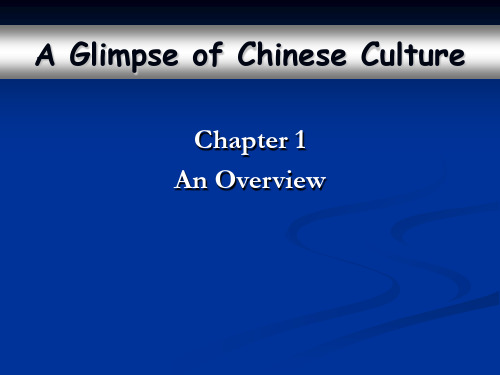
What’s your impression of the Yellow River?
The Yellow River is China’s second longest river; (5,464 km) The most heavily siltladen river in the world. The Yellow river catchment area is an important base for grains in China.
National Capital
On September 27, 1949, BeiPing was renamed as Beijing and became capital of the PRC. Beijing is not only the nation’s political centre, but also serves as tis economic, scientific amd cultural heart.
Yuanmou Man and Peking Man The Ancient Period The Modern Times
Yuanmou Man and Peking Man
The first primitive man known to have existed in China is Yuanmou Man, who lived 1.7 million years ago. Peking Man, who existed more than 400,000 years ago, could walk upright, make and use simple tools, and make use of fire.
A Glimpse of Chinese Culture《中国文化概论》讲义-chapters 1-8
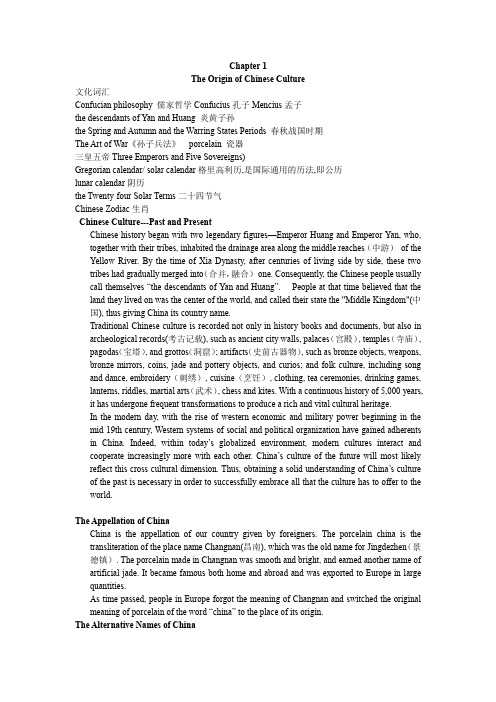
Chapter 1The Origin of Chinese Culture文化词汇Confucian philosophy 儒家哲学Confucius孔子Mencius孟子the descendants of Yan and Huang 炎黄子孙the Spring and Autumn and the Warring States Periods 春秋战国时期The Art of War《孙子兵法》porcelain 瓷器三皇五帝Three Emperors and Five Sovereigns)Gregorian calendar/ solar calendar格里高利历,是国际通用的历法,即公历lunar calendar阴历the Twenty-four Solar Terms二十四节气Chinese Zodiac生肖Chinese Culture---Past and PresentChinese history began with two legendary figures—Emperor Huang and Emperor Yan, who, together with their tribes, inhabited the drainage area along the middle reaches(中游)of the Yellow River. By the time of Xia Dynasty, after centuries of living side by side, these two tribes had gradually merged into(合并,融合)one. Consequently, the Chinese people usually call themselves “the descendants of Yan and Huang”.People at that time believed that the land they lived on was the center of the world, and called their state the "Middle Kingdom"(中国), thus giving China its country name.Traditional Chinese culture is recorded not only in history books and documents, but also in archeological records(考古记载), such as ancient city walls, palaces(宫殿), temples(寺庙), pagodas(宝塔), and grottos(洞窟); artifacts(史前古器物), such as bronze objects, weapons, bronze mirrors, coins, jade and pottery objects, and curios; and folk culture, including song and dance, embroidery(刺绣), cuisine(烹饪), clothing, tea ceremonies, drinking games, lanterns, riddles, martial arts(武术), chess and kites. With a continuous history of 5,000 years, it has undergone frequent transformations to produce a rich and vital cultural heritage.In the modern day, with the rise of western economic and military power beginning in the mid-19th century, Western systems of social and political organization have gained adherents in China. Indeed, within today’s globalized environment, modern cultures interact and cooperate increasingly more with each other. China’s culture of the future will most likely reflect this cross-cultural dimension. Thus, obtaining a solid understanding of China’s culture of the past is necessary in order to successfully embrace all that the culture has to offer to the world.The Appellation of ChinaChina is the appellation of our country given by foreigners. The porcelain china is the transliteration of the place name Changnan(昌南), which was the old name for Jingdezhen(景德镇). The porcelain made in Changnan was smooth and bright, and earned another name of artificial jade. It became famous both home and abroad and was exported to Europe in large quantities.As time passed, people in Europe forgot the meaning of Changnan and switched the original meaning of porcelain of the word “china” to the place of its origin.The Alternative Names of China⏹Chixian, Shenzhou(赤县、神州)⏹Jiuzhou (九州)⏹Hua ( 华)⏹Huaxia(华夏)⏹Zhonghua(中华)⏹Hainei(海内)Chinese MythologyChinese Mythology is a collection of cultural history, folktales(民间故事), and religions that have been passed down in oral or written form. Chinese mythology is similar to modern religion in that they both believe in relationships between mankind and a higher power.Historians have conjectured(推测)that Chinese mythology began in 12th century BC (close to the time of the Trojan War 特洛伊战争). The myths and legends were passed down in oral form for over a thousand years, before being written down in early book such as Shui Jing Zhu and Shan Hai Jing.The classification of myth神话的分类Creation myth 创世神话:Nvwa Created Man(女娲造人)Hero myth 英雄神话:Houyi Shooting the Sun(后羿射日)War myth 战争神话:Yellow Emperor Tackled Human-God(黄帝擒蚩尤)Cultural MosaicHeavenly Stems and Earthly BranchesThe standard Gregorian calendar is generally referred to as the solar calendar in China. The traditional Chinese lunar calendar, also known as the Jiazi calendar, counts the years in sixty-year cycles by combining two series of numbers---the 10 Heavenly Stems and 12 Earthly Branches.The Twenty-four Solar TermsThe traditional Chinese lunar year is divided into twenty-four solar terms, according to the position of the sun on the ecliptic in relationship to the earth. The solar terms designate agricultural periods, and can predict changing seasonal conditions, temperature, and weather throughout the course of the year. They are extremely important to agricultural production.Changes in the four seasons are determined by eight solar terms:立春( the Beginning of Spring),春分( the Spring Equinox ),立夏(the Beginning of Summer ),夏至(the Summer Solstice),立秋(the Beginning of Autumn),秋分( the Autumnal Equinox),立冬( the Beginning of Winter),冬至(the Winter Solstice )Changes in temperature are indicated by five solar terms:小暑Slight Heat ,大暑Great Heat ,处暑the Limit of Heat ,小寒Slight Cold ,大寒Great ColdChanging weather conditions are indicated by seven solar terms:雨水Rain Water ,谷雨Grain Rain ,白露White Dew ,寒露Cold Dew,霜降Frost's Descent ,小雪Slight Snow ,大雪Great Snow .Recurring natural phenomena are indicated by four solar terms:惊蛰the Waking of Insects ,清明Pure Brightness ,小满Grain Full,芒种Grain in EarChinese ZodiacIn ancient times, our ancestors counted the years with 10 heavenly stems and 12 earthly branches. Although this was scientific, most people were illiterate and could not memorize or calculate easily. Thus the animals that influenced people's lives were chosen to symbolize the terrestrial branches: the rat, ox, tiger, rabbit, dragon, snake, horse, sheep, monkey , rooster, dog and pig.Chapter 2 Culinary Culture文化词汇culinary厨房的,烹饪的;烹调用的cuisine烹饪,烹调法;菜肴main food主食,主粮(staple food )Fire temperature火候food tonic 食补“Food is the first necessity of the people”(“民以食为天。
中国文化概况Chapter1 ppt

National Anthem(国歌)
Arise, ye who refuse(拒绝) to be slaves(奴隶); Let us amount our flesh and blood towards our new Great Wall! The Chinese nation faces its greatest peril(困境), The thundering roar(轰鸣声) of our people will be heard! Arise! Arise! Arise! We are many, but our hearts beat as one! Selflessly(万众一心) braving the enemy’s gunfire(炮火), march on! Selflessly braving the enemy’s gunfire, march on! March on! March on! on!
serves as 充当 economic经济 scientific科学 cultural文化 Taking a bird’s-eye view 鸟瞰 geography 地理 plateau高原 basin 盆地 canal大运河 climate 气候
An outline history
National Day国庆节 National Emblem 国徽 National Anthem 国歌 National Capital 首都 in honour of 以纪念…… the People’s Republic of China (PRC)中华人民共和国 Communist Party of China中国共产党 Tian’anmen Rostrum城楼 New-Democratic Revolution 新民主革命 March of the Volunteers义勇军进行曲
中国文化概况1
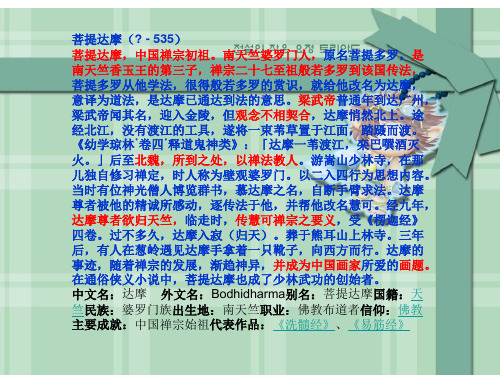
中文名称: 易筋经 英文名称: yijinjing;changing tendon exercise 定义: 锻炼筋肉以保健强身的导引方法。 所属学科: 中医药学(一级学科);推拿学、养生学、 康复学(二级学科)
相传中国南北朝时期,达摩祖师从印度经由海路东度来中土,在广州 上岸,北上游历中国各地,最后落脚於今日的河南嵩山少林寺。达摩 祖师在中国看到僧人长年静坐,多静少动,身体因此欠缺平衡而不健 康,於是於少林寺教导僧人健身的功夫以平衡其身心发展。后来达摩 祖师示寂并葬於少室山附近的熊耳山,因为传言有人看到祖师,后人 好奇的开棺察看,发现祖师遗骨已经消失,只留下一只鞋子於棺内。 接著僧人在祖师的遗物中发现一个胶封的铁箱,里面有两部以梵文著 作的经书,这两部书就是闻名的易筋经与洗髓经。
菩提达摩(? - 535) 菩提达摩,中国禅宗初祖。南天竺婆罗门人,原名菩提多罗,是 南天竺香玉王的第三子,禅宗二十七至祖般若多罗到该国传法, 菩提多罗从他学法,很得般若多罗的赏识,就给他改名为达摩, 意译为道法,是达摩已通达到法的意思。梁武帝普通年到达广州, 梁武帝闻其名,迎入金陵,但观念不相契合,达摩悄然北上。途 经北江,没有渡江的工具,遂将一束苇草置于江面,踏蹑而渡。 《幼学琼林˙卷四˙释道鬼神类》:「达摩一苇渡江,栾巴噀酒灭 火。」后至北魏,所到之处,以禅法教人。游嵩山少林寺,在那 儿独自修习禅定,时人称为壁观婆罗门。以二入四行为思想内容。 当时有位神光僧人博览群书,慕达摩之名,自断手臂求法。达摩 尊者被他的精诚所感动,逐传法于他,并帮他改名慧可。经九年, 达摩尊者欲归天竺,临走时,传慧可禅宗之要义,受《楞迦经》 四卷。过不多久,达摩入寂(归天)。葬于熊耳山上林寺。三年 后,有人在葱岭遇见达摩手拿着一只靴子,向西方而行。达摩的 事迹,随着禅宗的发展,渐趋神异,并成为中国画家所爱的画题。 在通俗侠义小说中,菩提达摩也成了少林武功的创始者。 中文名:达摩 外文名:Bodhidharma别名:菩提达摩国籍:天 竺民族:婆罗门族出生地:南天竺职业:佛教布道者信仰:佛教 主要成就:中国禅宗始祖代表作品:《洗髓经》、《易筋经》
中国文化概论课件

中国文化概论课件contents •中国文化概述•中国语言文字文化•中国传统艺术文化•中国古代科技文化•中国传统节日习俗文化•中国现代文化创新与发展目录01中国文化概述文化的定义与特点文化的定义文化是一个国家或民族在长期历史发展过程中所创造并传承下来的精神财富和物质财富的总和,包括语言、文字、艺术、科学、技术、哲学、宗教、风俗习惯等方面。
文化的特点文化具有多样性、历史性、传承性、创新性和共享性等特点。
不同地域、民族和时代所创造的文化各具特色,共同构成了丰富多彩的人类文化。
中国文化的起源与发展起源中国文化的起源可以追溯到远古时期,黄河流域的原始部落创造了最早的华夏文化,成为中华文化的源头。
发展随着历史的演进,中国文化经历了夏商周三代、春秋战国、秦汉、三国两晋南北朝、隋唐五代、宋辽夏金元、明清等历史时期,逐渐形成了独具特色的文化体系。
中庸儒家思想中的重要观念,主张在处理问题时保持中立和平衡,避免极端和偏激。
和谐中国传统文化中的核心理念之一,追求人与自然、人与社会、人与人之间的和谐共处。
诚信中国传统文化中的重要价值观之一,强调诚实守信、言行一致,是人际交往和社会秩序的基础。
仁爱儒家思想的核心价值观之一,强调人与人之间的关爱和尊重,追求和谐的人际关系。
中国文化的核心价值观02中国语言文字文化1 2 3介绍汉字的起源,包括结绳记事、八卦、图画等早期记事方式,以及仓颉造字的传说。
汉字的起源详细阐述汉字从甲骨文、金文、小篆、隶书、草书、楷书、行书的演变过程,以及各个时期汉字的特点和代表作品。
汉字的演变分析汉字的结构,包括象形、指事、会意、形声等造字法,以及汉字所蕴含的文化内涵和哲学思想。
汉字的结构与内涵汉字的起源与演变汉语的特点与魅力汉语的特点介绍汉语作为孤立语的特点,如缺乏形态变化、词序和虚词是重要的语法手段等。
同时,阐述汉语声调的作用和影响。
汉语的魅力探讨汉语在表达上的独特魅力,如丰富的词汇、灵活的句法、生动的修辞等。
中国文化内容课件

二、中国传统文化的研究范围
中国传统文化是指在氏族社会晚期、至少是 周秦以来到五四时期所形成和发展起来的,以 汉族为主体、包括其境内56个民族长期创造的 精神财富,即中华民族共同创造的华夏文化。 它以封建文化为主导,以儒学文化为主干。
第二节 中国传统文化的流变和分期
一、原始文化──传统文化的孕育期
第二节 儒家思想的第一次改造
──两汉经学神学化
一、董仲舒的神学思想和三纲五常伦理观
儒学由先秦百家争鸣的一家变为“独尊儒术”,
由民间学说变为官方意识,经过了董仲舒的改造。 他以奉天法古为旗号,先王之道为楷模,宣扬王权神授,建构 了天人感应为核心、阴阳五行为骨架的神学体系。他写《春秋 繁露》,为三纲五常的始作俑者。他以君为臣纲、父为子纲、 夫为妻纲,仁、义、礼、智、信等道德规范,作为建立法度、 化民成俗的根本,为封建专制提供了理论根据,为以儒为宗的 文化提供了蓝本。其理论以父子夫妻的家庭关系为依据,以封 建宗法制为基础,以君亲、忠孝为纽带,以移孝作忠为目的, 实现家族政治化和国家家族化。在义利上,他提倡“正其谊不 谋其利,明其道不计其功”,维护统治阶级的整体利益。在政 治上,他主张礼乐教化、德政为主、刑罚为辅。在思想文化上, 他主张罢黜百家,独尊儒术,完成了统一思想的最后一道工序。
三、荀子的隆礼重法和性恶论
荀子(荀况)将先秦儒学发展 到新阶段,不仅承认事物发展有客 观规律,而且强调主体能动作用。 这种对社会历史责任感的弘扬,是 中华民族刚健进取精神的反映。他 从“性本恶”出发,认为经过学习 和教化,“人皆可以为尧舜”。他 主张“隆礼重法”,强调礼在为人、 做事、治国方面的作用,礼是法的 根据,法的总纲;法是礼的体现, 礼的确认。只讲礼义,不讲法度; 只重教化,不重刑罚,不足以维护 x x 统治。
- 1、下载文档前请自行甄别文档内容的完整性,平台不提供额外的编辑、内容补充、找答案等附加服务。
- 2、"仅部分预览"的文档,不可在线预览部分如存在完整性等问题,可反馈申请退款(可完整预览的文档不适用该条件!)。
- 3、如文档侵犯您的权益,请联系客服反馈,我们会尽快为您处理(人工客服工作时间:9:00-18:30)。
Tarim Basin, the Junggar Basin (1000m-2000m)
Inner Mongolia Plateau, the Loess Plateau黄土高原
the North China Plain (北部平原) and the Middle-Lower Yangtze Plain(长江平原);(500-1000m)
The continental Shelf大陆架
Qinghai-Tibet Plateau(高原) (above4000m)
Yunnan-Guizhou Plateau and Sichuan Basin (1000m-2000m)
Rivers and Lakes 河流和湖泊
More than 1,500 rivers each drain 1,000 sq km or larger areas Source on the Qinghai-Tibet Plateau, rich in water –power(水能) resources 24,800 natural lakes
The Ancient Period古代史
Why are we called “the descendants(后裔) of Yan and Huang (炎黄子孙)”? Chinese history began with two legendary figures— Emperor(皇帝) Huang and Emperor Yan, who, together with their tribes(部落), inhabited(居住) the drainage(排水) area along the middle reaches (中游) of the Yellow River. By the time of Xia Dynasty(朝代), after centuries of living side by side, these two tribes had gradually merged into(合 并) one. Consequently, the Chinese people usually call themselves “the descendants of Yan and Huang”.
Grand Canal大运河
The Grand Canal is also called Jinghang Canal (1,801 km) The canal was open to navigation over 1,000 years ago. It passes through one city, four provinces and links five major rivers.
Forbidden City紫禁城
Ming Tombs明十三陵
Temple of Heaven天坛
Summer Palace颐和园
Great Wall 长城
Geography 地理
Location and Boundary Topography Rivers and Lakes Climate
Location and Boundary 区域
In the east of the Asia On the western shore of the Pacific Ocean Land area of about 9.6 million sq km, the third largest country
What’s your impression of the Yangtze River(长江)?
The longest river in China; (6,300km) Through 11 provinces, autonomous regions (自治区)and municipalities(直辖 市). The main artery(干线) of water transportation between eastern and western China.
serves as 充当 economic经济 scientific科学 cultural文化 Taking a bird’s-eye view 鸟瞰 geography 地理 plateau高原 basin 盆地 canal大运河 climate 气候
An outline history
Climate气候
A warm climate and distinct(明显的) seasons Continental monsoon(季风气候) climate in China: 1) cold and dry winters; 2) warm and humid summers;
Important words and phrases
March of the Volunteers(义勇军进行曲) was written in 1935 and was officially adopted as the national anthem of the PRC on December 4, 1982. The lyrics of March of the Volunteers goes as follow:
National Flag国旗
The color the The red design of of the
flag smaller symbolizes four stars (象征) (围绕) surrounding arevolution bigger one (革命) signifies( 意味着) and the yellow the unity (团结) color of the stars of the Chinese the golden brilliant people under the rays radiating(辐 leadership of the 射) from the vast Communist Party red land. of China (中国共 产党).
Topography地形
What are the features of Chinese topography?
Highlands in the west and plains in the east. Taking a bird’s-eye view of China(鸟瞰中 国), the terrain(地形) descends from the west to east like a four-staircase:
Brief Introduction to Chinese Symbols
National Day 国庆节 National Emblem 国徽 National Anthem 国歌 National Capital 首都
National Day国庆节
Chinese celebrate(庆祝) October 1 as National Day in honour of (以纪念) the founding of the People’s Republic of China (PRC)(中华人民共和国) on October 1, 1949.
National Emblem国徽
Composed of patterns of the national flag, the Tian’anmen Rostrum(城 楼), a wheel gear (齿轮) and ears of wheat(小麦 穗), it symbolizes the New-Democratic Revolution (新民主革命) of the Chinese people since the May 4th Movement in 1919 and the birth of New China.
Yuanmou Man and Peking Man The Ancient Period The Modern Times
Yuanmou Man and Peking Man
Hale Waihona Puke The first primitive man known to have existed in China is Yuanmou Man, who lived 1.7 million years ago. Peking Man, who existed more than 400,000 years ago, could walk upright(直 立), make and use simple tools.
What’s your impression of the Yellow River?
China’s second longest river; (5,464 km) The most heavily siltladen(泥沙淤积) river in the world. The Yellow river catchment area(下游) is an important base for grains(谷物) in China.
National Anthem(国歌)
Arise, ye who refuse(拒绝) to be slaves(奴隶); Let us amount our flesh and blood towards our new Great Wall! The Chinese nation faces its greatest peril(困境), The thundering roar(轰鸣声) of our people will be heard! Arise! Arise! Arise! We are many, but our hearts beat as one! Selflessly(万众一心) braving the enemy’s gunfire(炮火), march on! Selflessly braving the enemy’s gunfire, march on! March on! March on! on!
